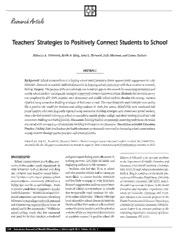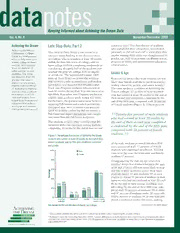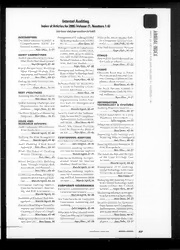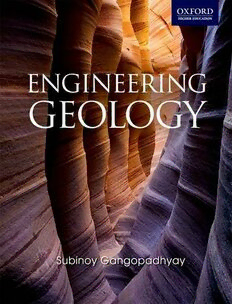
Preview Engineering Geology
ENGINEERING GEOLOGY (cid:54)(cid:88)(cid:69)(cid:76)(cid:81)(cid:82)(cid:92)(cid:3)(cid:42)(cid:68)(cid:81)(cid:74)(cid:82)(cid:83)(cid:68)(cid:71)(cid:75)(cid:92)(cid:68)(cid:92) Formerly, Senior Director Geological Survey of India 1 Prelims.indd i 10/19/2012 3:32:57 PM 3 Oxford University Press is a department of the University of Oxford. It furthers the University’s objective of excellence in research, scholarship, and education by publishing worldwide. Oxford is a registered trade mark of Oxford University Press in the UK and in certain other countries. Published in India by Oxford University Press YMCA Library Building, 1 Jai Singh Road, New Delhi 110001, India © Oxford University Press 2013 The moral rights of the author/s have been asserted. First published in 2013 All rights reserved. No part of this publication may be reproduced, stored in a retrieval system, or transmitted, in any form or by any means, without the prior permission in writing of Oxford University Press, or as expressly permitted by law, by licence, or under terms agreed with the appropriate reprographics rights organization. Enquiries concerning reproduction outside the scope of the above should be sent to the Rights Department, Oxford University Press, at the address above. You must not circulate this work in any other form and you must impose this same condition on any acquirer. ISBN-13: 978-0-19-808635-2 ISBN-10: 0-19-808635-0 Typeset in Times New Roman by Cameo Corporate Services Limited, Chennai Printed in India by Akash Press, New Delhi 110020 Prelims.indd ii 10/19/2012 3:32:57 PM This book is dedicated to the memory of my Mother for her everlasting love. Prelims.indd iii 10/19/2012 3:32:57 PM iv ● FFeeaattuurreess ooff tthhee BBooookk LEARNING OBJECTI VES Each chapter begins with ‘learning objectives’ After studying this chapter, the reader will be familiar with the following: setting the theme for the chapter followed by • Application of engineering geology in • History and development of civil engineering practice geology in India a short introductory paragraph on the subject • Knowledge that early Indians had on • Work-activities of engineerin matter of discussion in the chapter. stone construction since prehistoric times A number of photographs of actual project sites as well as illustrative diagrams are interspersed in the text for better understanding of the theory. Fig. 18.5 An arch bridge 18.11 CASE STUDIES ON BRIDGES INCLUDING A COLLAPSED BRIDGE Case studies have been provided in relevant A bridge construction usually encounters several types of problems that chapters to present real-life situations so that adverse geology of the bridge site, especially in relation to the weak foun of the piers. Geotechnical investigation helps to identify the weakness of t students are able to relate to the concepts specify correct treatment. The following case studies are presented to give discussed in the chapters. of the problems faced at the bridge sites of varied geological set-ups and the 2233 Guidelines for Writing an Engineering Geology Report Chapter 23 provides guidelines for preparing engineering geology reports. The field work required to collect basic data to be included in LEARNING OBJECTI VES such reports is also discussed in this chapter. After studying this chapter, the reader will be familiar with the following: • Purpose of preparing an engineering • Fieldwork required for collectin geology report data to include in the report • Procedure for writing an engineering • Utility of in-fi eld preparation o geology report draft Prelims.indd iv 10/19/2012 3:32:57 PM SUMMARY is the application of •The work of an engineering geologist at the initial civil engineering practices stages of an engineering project includes geological The summary at the end of each chapter esign, and construction. mapping, subsurface evaluation by drillings, search ng was known in India for construction materials, and determination of revisits all the important points discussed in the es when buildings and rock/soil properties. At the construction stage, it using hard and durable involves the study of the conditions of foundations chapter making for a fine guide for revision. ed. Numerous buildings, of engineering structures and suggestion of s, dams, and irrigation corrective measures for geological defects. dia in early historic times. •Investigating natural hazards such as earthquakes work started in India as and landslides and identifying measures for their Multiple Choice Questions 5. The structure that proves th the art of engineering even i Choose the correct answer from the choices given: (a) t he sluice structure for wa In all chapters multiple choice questions and 1. In the investigation of a site for construction of (b) t he embankments and an engineering structure, an engineering geologist century AD review questions are given to test students’ aims at: (c) both (a) and (b) (a) stability of the structure 6. The rock type that was use understanding of concepts learnt from the (b) economy of its construction Sanchi Stupa is: (c) both (a) and (b) (a) pink granite chapters. Review Questions weapons and domestic articl where Stone Age men lived 1. Discuss how the mutual relationship between the two 5. By whom and when was Si disciplines—geology and engineering geology— the guidelines mentioned in resulted in engineering geology. the use of rock/soil for cons NUMERICAL EXERCISES y testing, while determining the maximum of 300 kg-cm to bring about failure of the Numerical problems along with answers are the weight of the density bottle was soil. Calculate the shear strength of the soil. . The soil sample after drying in the [Answer: Shear strength = 0.379 kg/cm2] provided in those chapters where there is a g was weighed as 35.38 g. The bottle 3.In an analysis of 200 g of soil particles, the s then fi lled with distilled water and following result was recorded with respect to their requirement. In some cases hints are also 20.21 g and the bottle with water to size distribution: coarse gravel 80 g, fi ne gravel d the specifi c gravity (G) of the soil 50 g, coarse sand 30 g, medium sand 20 g, fi ne sand given. 15 g, and silt with clay 5 g. Draw a cumulative curve [Answer: G = 2.12] showing the distribution of particles. AAPPPPEENNDDIIXX Two appendices on dams and tunnels in AA Geotechnical Problems of Dams India have been provided at the end of the and Their Solutions book. These appendices highlight the adverse geological conditions encountered during AAPPBBPPEENNDDIIXX the construction of dams and the remedial Geotechnical Problems of Tunnels measures undertaken. and Their Solutions Prelims.indd v 10/19/2012 3:32:57 PM Preface It is said that one who learns from one’s own experience is smart, but one who learns from other’s experiences is smarter. This book is the outcome of the author’s several years of experience of working on diverse projects in India and abroad. This book attempts to share his rich and varied experience with students—the future geologists and engineers—so that they are better able to assess and handle the geotechnical problems of different project sites effectively. The book is written in an Indian context using exhaustive examples from Indian case studies to elucidate the theoretical concepts discussed in the chapters and to help in solving practical problems. The investigative approach including techniques of site works discussed in this book are in line with those practised by the geologists of the Geological Survey of India (GSI) while collaborating with engineers in planning, designing, and constructing varied engineering projects across the country. Initially, geological problems related to civil constructions were handled by geologists of GSI. But with time civil engineers started working hand in hand with geologists to fi nd solutions to the numerous geotechnical problems encountered in different engineering projects. Thus, gradually engineering geology became an important subject of study especially for civil engineering professionals. Like any new branch of study, engineering geology has also advanced at a fast pace. In fact, engineering problems and adverse conditions of project sites faced during construction of civil engineering projects were treated successfully by Indian engineers and geologists. The advances in the nature of geological works are also more pronounced compared to the early days. New methodologies such as satellite imagery and remote sensing techniques, and exploratory works using rotary drilling now provide accurate geological knowledge of both surface and subsurface strata. But our progress in using computers in geological works is yet to develop as in the western countries. In the West, IT based working in engineering geology is part of the curriculum. The future of engineering geology lies in the applications of geographic information system (GIS), remote sensing information provided by orbiting satellites, and IT based 3D imagery systems. About the Book This textbook aims to impart comprehensive knowledge of engineering geology to the undergraduate students of civil engineering and graduate and postgraduate students of geology, applied geology, and mining geology. It will also serve as a reference book for practising civil engineers and professional engineering geologists. The book deals with both the principles and practices of engineering geology. Because of the author’s rich experience of working with various types of engineering projects such as dams, tunnels, bridges, and having been involved in disaster management activities in cases of natural calamities across the world such as earthquakes, landslides, and tsunamis, he has focussed on the practical aspects that will come in handy for geology students. The subject matter of each chapter is elucidated with the help of maps, diagrams, and images including fi eld pictures mostly taken by the author during his visits to different parts of the world. Factual data related to different aspects of discussions has been incorporated in the form of tables for ready reference. Solved examples wherever applicable have been included in the chapters. The important points covered in the chapters are recapitulated in the form of summary Prelims.indd vii 10/19/2012 3:32:58 PM viii ● Preface at the end of the chapters. Further, a section on exercises comprising review questions, multiple- choice questions, and numerical exercises is also provided at the end of each chapter. Several books, websites, and literature on engineering geology including journals of the Indian Society of Engineering Geology (ISEG) and journals of the International Association of Engineering Geology (IAEG), and published records of GSI on geological works of the past till date were consulted while preparing the text of this book. The references of all these pertinent books/papers with author’s name, year of publication, and other relevant details have been listed in the ‘References’ section at the end of the book. Salient Features of the Book • The book provides examples of various geological sites in the country to give an Indian context to the book. It also closely follows the works done by GSI, the premium institute in India involved in geological works in the country. • The subject matter of each chapter has been illustrated by numerous fi gures and actual pictures of geological features taken from project sites to simplify the concepts discussed in the book. • Chapter-end summary is provided in each chapter so that at a glance student can recollect the main aspects of the chapter. • Geological reports are an important part of a professional geologists’ work. A chapter is devoted to providing guidelines on writing good geological reports for designing project sites. • The appendices at the end of the book include case histories of major Indian dams and tunnels. The discussion on the different types of hurdles which arose during their construction and the remedial measures adopted will be of special interest to practising civil engineers and professional geologists. • Many parts of the world and several states of India—especially the eastern region and parts of central India—have problems related to karstic limestone, where special investigations such as speleological and tracer studies are necessary. This important aspect, which does not fi nd mention in most other engineering geology books, is discussed as an exclusive chapter. Content and Coverage The book consists of 24 chapters and two appendices. Chapter 1 introduces engineering geology with a discussion on the importance of engineering geology in civil engineering and the work-activities of engineering geologists. Chapters 2, 3, and 4 deal with rocks, minerals, and rock structures and weathering of rocks and its impact on constructions. Chapter 5 discusses the different types of soils and their classifi cation. Chapter 6 deals with soil mechanics—laboratory analysis of soil, determination of soil permeability, density measurement, and consolidation and compactness tests. Chapter 7 discusses the hydraulic parameters of a river followed by its activities and the utility of the river deposits. Chapter 8 highlights the geological works of oceans and coastal management. It also includes a case study on coastal erosion. Chapter 9 analyses the various aspects of subsurface water in relation to its engineering signifi cance. The processes involved in the hydrologic cycle to maintain the earth’s water equilibrium are also discussed. Prelims.indd viii 10/19/2012 3:32:58 PM Preface ● ix Chapter 10 highlights the importance of rock mechanics in engineering geology and civil engineering works. Chapter 11 discusses the different stages of investigation of engineering project sites. Different methods of geophysical explorations are also discussed. Chapter 12 discusses different types of rock materials including their characteristics and utilities. Petrological study of alkali- reactive minerals and other deleterious materials are also discussed. Chapter 13 discusses the different aspects of grouting in rocks and other materials. It also discusses the types of grouting, ingredients used in a grout mix, grouting patterns, and factors considered for fi nding the effi cacy of grouting. Chapter 14 explains the different aspects of dams, their utility, functions, investigation approaches during site selection, and construction stages as also post-construction stages. It also discusses different types of spillways and their working. Chapter 15 deals with reservoirs, their effect on the geo-hydrology of the neighbouring area, the sedimentation and degradation process of reservoir capacity, and the environmental effect due to the creation of a reservoir. Chapter 16 classifi es different types of tunnels, before explaining the geotechnical aspects of tunnel construction, problems in tunnelling and their solutions, and methods and machineries of tunnel construction. Chapter 17 deals with different types of powerhouses and their functions. Some case studies on power houses are also discussed. Investigation methods for nuclear and thermal powerhouses are also presented. Chapter 18 on bridges explains the functions of superstructures and substructures of bridges. It describes the different types of bridges and the forces acting on them. The bridge components and supports systems are also elucidated. A case study on bridge foundation problems and their remedial measures are also presented. Chapter 19 deals with highways, canals, runways, power channels, and fl umes. Chapter 20 discusses natural hazards such as earthquakes and tsunamis and explains the methods of forecasting them. The chapter also adds a note on the various remedial measures that can be adopted following a disaster. Chapter 21 discusses landslide evaluation and mitigation. It also talks about geological, man-made, and natural causes of landslides and the preparation of landslide hazard zonation map and mitigation measures. Chapter 22 is on karstic terrain investigation. The origin of karst topography and processes responsible for formation of large cavities in surface and subsurface investigation methods including speleologist study of underground caverns are discussed in this chapter. The chapters also adds a note on the problems of creating reservoirs in karstic terrains. Chapter 23 presents guidelines for writing geological reports. The fi eld work required to collect basic data to be included in such reports is also discussed. Chapter 24 deals with physiography, stratigraphy, and ores and minerals of India. Without adequate knowledge of these aspects, the engineering geology study especially in the Indian perspective will be incomplete. Appendices A and B include examples of some Indian dams and tunnels successfully built in various rock formations in different parts of India including the Himalayan terrain. These appendices highlight the adverse geological conditions encountered during the construction of these engineering structures and the remedial measures adopted. Chapter 14 on dams and Chapter 16 on tunnels may be read in conjunction with Appendices A and B respectively to impart knowledge on the adverse geological conditions of the construction sites of major dams and tunnels and their rectifi cation measures. Prelims.indd ix 10/19/2012 3:32:58 PM x ● Preface Acknowledgement I am indebted to many world-renowned engineering geologists and specialists in soil and rock mechanics for sharing their knowledge with me during my service life. Special thanks especially to Dr J.B. Auden, renowned engineering geologist and former Chief of Water Resource Development, UN, Dr N. Burton, expert in rock mechanics, and Dr L. Bjerrum, specialist in soil mechanics and former Head, Norwegian Geotechnical Institute, Oslo, with whom I had the rare privilege of working. I am indebted to his guidance and constant encouragement in my research on engineering geology and geotechnics. I would like to thank my colleagues at GSI and engineers of various state and central government departments with whom I worked for a long period and got inspiration for writing this book. I am especially thankful to A.K. Chowdhury, N. Majumdar, M. Bandopadhyay, and S. Chakrabarty, retired directors and experienced engineering geologists of GSI, who have gone through the different chapters of the manuscript and provided valuable suggestions for improvement of the book. I am also indebted to D.N. Bhattacharya, C. Paul, and B.C. Poddar— my colleagues at GSI for providing me with several illustrative fi eld photographs and fruitful discussions on specifi c subject matter related to this book. This work would not have been completed without the dynamic effort of my daughter Shampa and son-in-law Asit Chakrabarty, both computer engineers in the US. They were a constant source of inspiration while writing this book and assisted me immensely in computer- processing of the entire manuscript including computer-drawing of illustrations and scanning of fi gures and photographs. Subinoy Gangopadhyay Prelims.indd x 10/19/2012 3:32:58 PM
The list of books you might like

Atomic Habits James Clear

The 48 Laws of Power

$100m Offers

Haunting Adeline

Sandkings
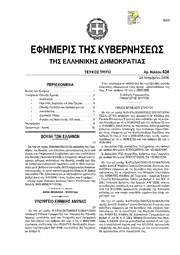
Greek Government Gazette: Part 3, 2006 no. 434
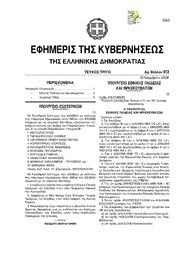
Greek Government Gazette: Part 3, 2006 no. 413
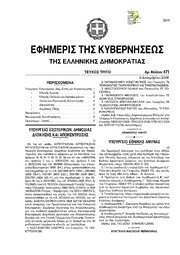
Greek Government Gazette: Part 3, 2006 no. 471

Argo
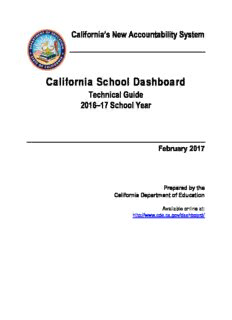
CA New Accountability System - California Accountability & School Dashboard
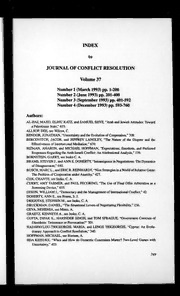
The Journal of Conflict Resolution 1993: Vol 37 Index

Long Way Down
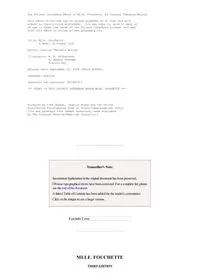
Mlle Fouchette by Charles Theodore
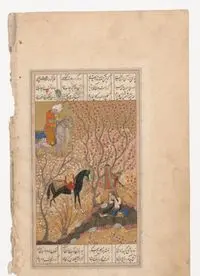
rbsc isl msp-leaf 018
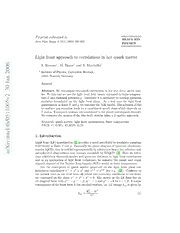
Light front approach to correlations in hot quark matter

Wakhal Nachom
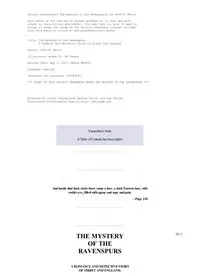
The Mystery Of The Ravenspurs by Fred M White
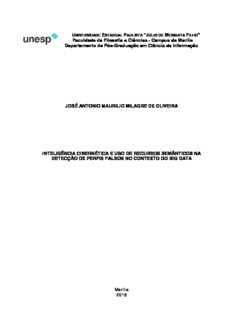
Campus de Marília Departamento de Pós-Graduação em Ciência da Informação JOSÉ ANTON
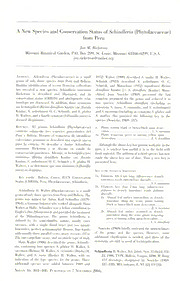
A new species and conservation status of Schindleria (Phytolaccaceae) from Peru
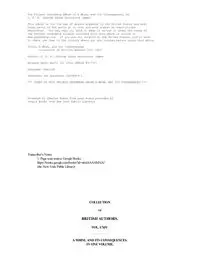
A Whim and Its Consequences

